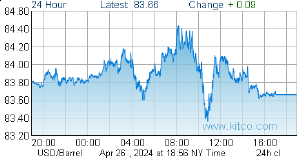TSX Venture Exchange and Gold
The Venture Exchange (CDNX) continued its climb last week, gaining 70 points or 3% to close at 2314. While the rally since the yearly low of 2054 March 15 has been impressive in terms of total points (260 or 13%) over just nine trading sessions, volume has declined considerably and that’s a major concern. A market that rises on decreasing volume is a signal that buying pressure is faltering, plain and simple. While the overall and long-term Venture Exchange bull market remains intact, significant near-term risks exist.
In addition, the CDNX is now under-performing the broader markets (the CDNX is up just 1% this year vs. gains of 5.5%, 4.4% and 3.3% for the Dow, TSX and Nasdaq, respectively) after significantly out-performing those markets over the last half of 2010. This raises a “cautionary flag” as the CDNX is an extremely reliable leading indicator. Investors are seeing more geopolitical and other risks right now and that has them less inclined at the moment to throw their money into speculative and risky junior mining stocks. This can change very quickly, however.
The 2314 close Friday puts the CDNX just a few points below its slightly rising 50-day moving average (SMA) and just a few points above the 20-day SMA which continues to fall. The Index is currently in a zone of resistance but it’s also underpinned by support at 2300. The final four trading days of the month should determine which way this market is going to turn – it will either break to the upside and take a run at the previous high of 2465, or it will weaken and fall below 2300. We will patiently wait for the market to tell us what it wants to do. The possibility of a three-wave correction, taking the Index down about 20% from current levels, still exists. For this market to head higher, volume must increase while the RSI and Slow Stochastics indicators must break above their resistance trendlines as John’s chart that we posted Friday morning clearly indicates:
Let’s review in point form why we still remain cautious over the immediate to short-term regarding the CDNX:
- The market has clearly met powerful resistance between 2438 (the Feb. 22 high) and 2465 (the March 7 high). It is now in a new zone of resistance in the immediate vicinity of the 50-day SMA;
- Exhaustion appears to have set in – the CDNX climbed 83.5% over eight months. Buying pressure was at a level (“pivot point”) where other pullbacks have started;
- The CDNX is now significantly under-performing the major markets. Given the fact the CDNX is such a reliable leading indicator, this suggests to us an increased risk of a major broad market reversal or even a correction in precious metals and commodities across the board;
- The CDNX fell below its 50-day SMA March 10 for the first time since the start of the big run last summer. In almost all cases over the last decade, with the notable exception of 2009, a drop below the 50-day SMA following a significant uptrend has preceded a major correction. The market did fall sharply after March 10 to a low of 2054 March 15 – the question is, was this the end of the correction or just the first leg of the correction?
- The CDNX’s 50-day SMA started to decline March 14, a negative sign, though it has recently reversed again. The sell-off started in earnest when the market first fell below its 50-day SMA, so naturally this is now an area of resistance (2321) which is why the market reacted when it got as high as 2328 Thursday;
- The 20-day moving averages continues to decline which is a problem for this market right now – a reversal in this pattern is imperative and would attract fresh buying interest. The 10 and 50-day moving averages have reversed to the upside and those are positive developments. The 100, 200 and 300-day SMA’s remain in bullish alignment which confirms the long-term trend;
- Volume on the rally since March 15 has been relatively low;
- It can be interpreted that the CDNX is in the midst of a 3-wave, A-B-C correction based on the chart patterns;
- The current market pattern has similarities to the May-June, 2006, correction when the CDNX fell nearly 30%;
- Too many individual stocks are technically weak;
- The fact the CDNX would experience weakness at a time when Gold is hitting new all-time highs, and commodities in general have been very strong, is a serious negative development;
- The geopolitical backdrop is not positive – major confusion and uncertainty on the world stage quickly chase investors away from the world’s most speculative market, the CDNX.
Fundamental factors could quite possibly create a very difficult environment for stocks over the coming days and weeks, though markets have a tendency sometimes to climb a “wall of worry” for an extended period. Continued unrest and uncertainty in the Middle East, the potential of rising oil prices due to this unrest as well as demand/supply dynamics, debt problems from Europe to the United States, U.S. budgetary battles, inflation concerns and rising interest rates in some parts of the world, austerity measures introduced by certain governments, and now the near-term negative affects of the problems in Japan are all factors that could create a bumpy road ahead for the markets. In Canada, a critical federal election is now set for May 2. At the very least the market wants to see a strong Conservative minority government and anything short of that will cause considerable anxiety among many investors.
Gold hit a new intra-day all-time high of nearly $1,450 Thursday before pulling back and finishing the week up $10 an ounce at $1,430. Silver enjoyed a strong week and jumped $2.04 to 37.28. Silver has had a spectacular run recently, and one thing that concerns us is that steep rises like we’ve seen in Silver and such out-performance against Gold have often occurred before corrections in precious metals.
The fundamental case for Gold remains incredibly strong – currency instability and an overall lack of confidence in fiat currencies, an extended period of negative real interest rates (inflation is greater than the nominal interest rate, even in China and India despite increasing rates there), massive government debt from the United States to Europe, central bank buying, flat mine supply, physical demand, investment demand, emerging market growth, geopolitical unrest and conflicts (with the volatile Middle East being the focus right now), rising oil prices…the list goes on. It’s hard to imagine Gold not performing well in this environment. However, one cannot rule out the possibility of another correction prior to a fresh advance that takes Gold beyond $1,500.
Despite signs of an improving U.S. economy, the Fed is expected to error on the side of caution and maintain its accommodative monetary policy for an extended period which is bullish for precious metals and commodities in general. The Fed will want to see payroll gains in excess of 200,000 for at least six to nine months and a significant decline in unemployment before withdrawing its massive monetary support (QW2). The current U.S. economic expansion is just 20 months old (expansions since WW2 have tended to be at least 60 months) and there are still significant risks to the economy including troubling high levels of debt at every level of government, a housing market that is still very weak (one in four mortgages are underwater and prices continue to decline in many areas) and now an increase in oil prices which has the potential of hitting consumers hard. Interest rate increases in the U.S. appear to be out of the question until at least sometime next year. Overall, this is the type of environment that’s very supportive of Gold and a speculative commodity-driven market such as the CDNX which is why we see any pullback in the CDNX, minor or major, as merely a correction within a powerful ongoing bull phase. Any hint of a global economic slowdown, due to a combination of factors, may convince the Fed to launch QE3 after QE2 expires in June.
A couple of interesting developments last week on the Gold front:
The Utah legislature passed a bill allowing Gold and Silver coins to be used as legal tender in the state, according to the true value of the metal in the coins and not by the face value stated on the coin. Similar proposals have been developed in Colorado, Georgia, Indiana, Iowa, Missouri, Montana, New Hampshire, Oklahoma, South Carolina, Tennessee, Vermont, and Washington.
In India, standard 24-carat Gold coins have been selling extremely well at more than 466 post offices throughout the country. Despite the high price, Indian consumers have been buying small quantities of coins to give during the festival season.
 BullMarketRun.com
BullMarketRun.com











